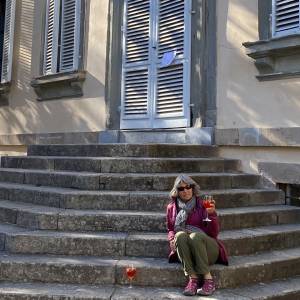The Etruscans of Umbria
Museum day in the big city of Perugia. We took the Mini-Metro (extra), Perugia’s funicular V version of a worm-hole, up to the historical center. Perugia is one of the twelve cities of the Etruscan League and Etruscan History was today’s theme. We started near the highest point of the city (477 m a.s.l) by climbing about a quarter of the way down into the vault of an Etruscan well. Built in the second half of the 3rd century BC, the well descends to a depth of about 37 m and is still supplied by three springs. It is one of the most important examples of Etruscan hydraulic engineering and architecture. The extra photo is the view looking down into the well at the footbridge we stood on minutes later, which we accessed by an adjacent narrow stone stairway. Next up, was a trip to the museum. The National Archeology Museum in Umbria houses an extensive collection of Etruscan funerary urns, sarcophagi, and the art and artifacts buried along with them. The brilliant blue “mosaic” glass bowl (featured) was discovered in 2007 in one of these tombs from the first half on the 2nd century BC. As someone who has broken my fair share of delicate dishware, I am amazed that such a beautiful glass bowl has survived over 2000 years! Heading back to the Mini-Metro, we walked through the Etruscan Arch or Arch of Augustus (extra). It is one of two surviving gates, of the original eight gates, in the Etruscan Wall surrounding “Perusia”. The 60 foot high gated wall was constructed about the same time as the Etruscan Well further up the hill, and “restored” in 40 BC by Augustus after his victory of the Perusine war; possibly an excuse to carve his name on the arch. About 1500 years later, the ‘medieval loggia’ was added on top of the left tower, and the fountain below on the same tower was added about a century later. Quite the architectural mixed bag.
- 0
- 0
- Apple iPhone 14 Pro
- 1/33
- f/1.8
- 7mm
- 250

Comments
Sign in or get an account to comment.


